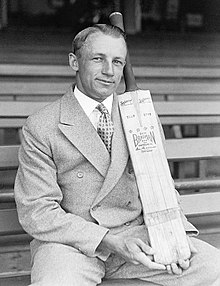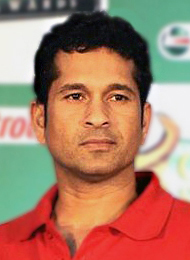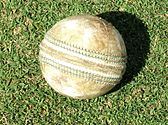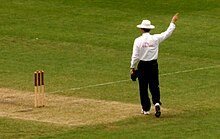Cricket is a bat-and-ball game played between two teams of 11 players on a field at the centre of which is a rectangular 22-yard long pitch. Each team takes it in turn to bat, attempting to score runs, while the other team fields. Each turn is known as an innings.
The bowler delivers the ball to the batsman who attempts to hit the ball with his bat far enough for him to run to the other end of the pitch and score a run. Each batsman continues batting until he is out. The batting team continues batting until ten batsmen are out, at which point the teams switch roles and the fielding team comes in to bat.
In professional cricket the length of a game ranges from 20 overs of six bowling deliveries per side to Test cricket played over five days. The Laws of Cricket are maintained by theInternational Cricket Council (ICC) and the Marylebone Cricket Club (MCC) with additional Standard Playing Conditions for Test matches and One Day Internationals.[1]
Cricket was first played in southern England in the 16th century. By the end of the 18th century, it had developed into the national sport of England. The expansion of the British Empire led to cricket being played overseas and by the mid-19th century the first international matches were being held. The ICC, the game's governing body, has 10 full members.[2] The game is most popular in Australasia, England, the Indian subcontinent, the West Indies and Southern Africa.
Contents
[show]History
Main article: History of cricket
Early cricket was at some time or another described as "a club striking a ball (like) the ancient games of club-ball, stool-ball, trap-ball, stob-ball".[3] Cricket can definitely be traced back to Tudor times in early 16th-century England. Written evidence exists of a game known as creag being played by Prince Edward, the son of Edward I (Longshanks), at Newenden, Kent in 1301[4] and there has been speculation, but no evidence, that this was a form of cricket.
A number of other words have been suggested as sources for the term "cricket". In the earliest definite reference to the sport in 1598,[5] it is called creckett. Given the strong medieval trade connections between south-east England and the County of Flanders when the latter belonged to the Duchy of Burgundy, the name may have been derived from the Middle Dutch[6] krick(-e), meaning a stick (crook); or the Old English cricc or cryce meaning a crutch or staff.[7] In Old French, the word criquet seems to have meant a kind of club or stick.[8] In Samuel Johnson's Dictionary, he derived cricket from "cryce, Saxon, a stick".[9] Another possible source is the Middle Dutch word krickstoel, meaning a long low stool used for kneeling in church and which resembled the long low wicket with two stumps used in early cricket.[10] According to Heiner Gillmeister, a European language expert of Bonn University, "cricket" derives from the Middle Dutch phrase for hockey, met de (krik ket)sen (i.e., "with the stick chase").[11] Dr Gillmeister believes that not only the name but the sport itself is of Flemish origin.[12]
The earliest definite reference to cricket being played in England (and hence anywhere) is in evidence given at a 1598 court case which mentions that "creckett" was played on common land in Guildford, Surrey, around 1550. The court in Guildford heard on Monday, 17 January 1597 (Julian date, equating to the year 1598 in the Gregorian calendar) from a 59 year-old coroner, John Derrick, who gave witness that when he was a scholar at the "Free School at Guildford", fifty years earlier, "hee and diverse of his fellows did runne and play [on the common land] at creckett and other plaies."[13][14] It is believed that it was originally a children's game but references around 1610[14] indicate that adults had started playing it and the earliest reference to inter-parish or village cricket occurs soon afterwards. In 1624, a player called Jasper Vinall was killed when he was struck on the head during a match between two parish teams in Sussex.[15]
During the 17th century, numerous references indicate the growth of cricket in the south-east of England. By the end of the century, it had become an organised activity being played for high stakes and it is believed that the first professionals appeared in the years following the Restoration in 1660. A newspaper report survives of "a great cricket match" with eleven players a side that was played for high stakes in Sussex in 1697 and this is the earliest known reference to a cricket match of such importance.
The game underwent major development in the 18th century and became the national sport of England. Betting played a major part in that development with rich patrons forming their own "select XIs". Cricket was prominent in London as early as 1707 and large crowds flocked to matches on the Artillery Ground in Finsbury. The single wicket form of the sport attracted huge crowds and wagers to match. Bowling evolved around 1760 when bowlers began to pitch the ball instead of rolling or skimming it towards the batsman. This caused a revolution in bat design because, to deal with the bouncing ball, it was necessary to introduce the modern straight bat in place of the old "hockey stick" shape. The Hambledon Club was founded in the 1760s and, for the next 20 years until the formation of MCC and the opening of Lord's Old Ground in 1787, Hambledon was both the game's greatest club and its focal point. MCC quickly became the sport's premier club and the custodian of the Laws of Cricket. New Laws introduced in the latter part of the 18th century included the three stump wicket and leg before wicket (lbw).
The 19th century saw underarm bowling replaced by first roundarm and then overarm bowling. Both developments were controversial. Organisation of the game at county level led to the creation of the county clubs, starting with Sussex CCC in 1839, which ultimately formed the official County Championship in 1890. Meanwhile, the British Empire had been instrumental in spreading the game overseas and by the middle of the 19th century it had become well established in India, North America, the Caribbean, South Africa, Australia and New Zealand. In 1844, the first international cricket match took place between the United States and Canada (although neither has ever been ranked as a Test-playing nation).
In 1859, a team of England players went on the first overseas tour (to North America). The first Australian team to tour overseas was a team of Aboriginalstockmen who travelled to England in 1868 to play matches against county teams.[17] In 1862, an English team made the first tour of Australia and in 1876–77, an England team took part in the first-ever Test match at the Melbourne Cricket Ground against Australia.
W.G. Grace started his long career in 1865; his career is often said to have revolutionised the sport.[18] The rivalry between England and Australia gave birth to The Ashes in 1882 and this has remained Test cricket's most famous contest[citation needed]. Test cricket began to expand in 1888–89 when South Africa played England. The last two decades before the First World War have been called the "Golden Age of cricket". It is a nostalgic name prompted by the collective sense of loss resulting from the war, but the period did produce some great players and memorable matches, especially as organised competition at county and Test level developed.
The inter-war years were dominated by one player: Australia's Don Bradman, statistically the greatest batsman of all time. It was the determination of the England team to overcome his skill that brought about the infamous Bodyline series in 1932–33, particularly from the accurate short-pitched bowling ofHarold Larwood. Test cricket continued to expand during the 20th century with the addition of the West Indies, India, and New Zealand before the Second World War and then Pakistan, Sri Lanka, and Bangladesh in the post-war period. However, South Africa was banned from international cricket from 1970 to 1992 because of its government's apartheid policy.
Cricket entered a new era in 1963 when English counties introduced the limited overs variant. As it was sure to produce a result, limited overs cricket was lucrative and the number of matches increased. The first Limited Overs International was played in 1971. The governing International Cricket Council (ICC) saw its potential and staged the first limited overs Cricket World Cup in 1975. In the 21st century, a new limited overs form, Twenty20, has made an immediate impact.
Rules and game-play
Main article: Laws of cricket
Summary
Cricket is a bat and ball game, played between two teams of eleven players each.[19][20] One team bats, attempting to score runs, while the other bowls and fields the ball, attempting to restrict the scoring and dismiss the batsmen. The objective of the game is for a team to score more runs than its opponent. In some forms of cricket, it may also be necessary to dismiss the opposition in order to win the match, which would otherwise be drawn.
Format of the game
A cricket match is divided into periods called innings. It is decided before the match whether each team will have either one innings or two innings each. During an innings (innings ends with "s" in both singular and plural form), one team fields and the other bats. The two teams switch between fielding and batting after each innings. All eleven members of the fielding team take the field, but only two members of the batting team (two batsmen) are on the field at any given time.
The two batsmen stand at opposite ends of the pitch, each behind a line on the pitch known as a crease. The fielding team's eleven members stand outside the pitch, spread out across the field.
At each end of the pitch is a wooden target called a wicket. One designated member of the fielding team, called the bowler, is given the ball, and bowls the ball from one end of the pitch to the wicket behind the batsman on the other side of the pitch. The batsman tries to prevent the ball from hitting the wicket by striking the ball with a bat. If the bowler succeeds in hitting the wicket the batsman is dismissed. A dismissed batsman must leave the field, to be replaced by another batsman from the batting team.
If the batsman is successful in striking the ball and the ball is not caught before it hits the ground, the two batsmen may then try to score points (runs) for their team by running the length of the pitch, grounding their bats behind the opposite crease. Each crossing and grounding by both batsmen is worth one run. The batsmen may attempt one run, multiple runs, or elect not to run at all. By attempting runs, the batsmen risk dismissal, which can happen if the fielding team retrieves the ball and hits a wicket with the ball before either batsman reaches the opposite crease.
If the batsman hits the bowled ball over the field boundary without the ball touching the field, the batting team scores six runs and may not attempt more. If the ball touches the ground and then reaches the boundary, the batting team scores four runs and may not attempt more. When the batsmen have finished attempting their runs, the ball is returned to the bowler to be bowled again. The bowler continues to bowl toward the same wicket, regardless of any switch of the batsmen's positions.[21]
After a bowler has bowled six times (an over), another member of the fielding team is designated as the new bowler. The new bowler bowls to the opposite wicket, and play continues. Fielding team members may bowl multiple times during an innings, but may not bowl two overs in succession.
The innings is complete when 10 of the 11 members of the batting team have been dismissed, one always remaining "not out", or when a set number of overs has been played. The number of innings and the number of overs per innings vary depending on the match.
Pitch, wickets and creases
See also: Stump (cricket) and Bail (cricket)
Playing surface
Cricket is played on a grassy field.[22] The Laws of Cricket do not specify the size or shape of the field,[23] but it is often oval. In the centre of the field is a rectangular strip, known as thepitch.[22]
The pitch is a flat surface 10 feet (3.0 m) wide, with very short grass that tends to be worn away as the game progresses.[24] At either end of the pitch, 22 yards (20 m) apart, are placed wooden targets, known as the wickets. These serve as a target for the bowling (also known as the fielding) side and are defended by the batting side, which seeks to accumulate runs.
Stumps, bails and creases
Each wicket on the pitch consists of three wooden stumps placed vertically, in line with one another. They are surmounted by two wooden crosspieces called bails; the total height of the wicket including bails is 28.5 inches (720 mm) and the combined width of the three stumps, including small gaps between them is 9 inches (230 mm).
Four lines, known as creases, are painted onto the pitch around the wicket areas to define the batsman's "safe territory" and to determine the limit of the bowler's approach. These are called the "popping" (or batting) crease, the bowling crease and two "return" creases.
The stumps are placed in line on the bowling creases and so these creases must be 22 yards (20 m) apart. A bowling crease is 8 feet 8 inches (2.64 m) long, with the middle stump placed dead centre. The popping crease has the same length, is parallel to the bowling crease and is 4 feet (1.2 m) in front of the wicket. The return creases are perpendicular to the other two; they are adjoined to the ends of the popping crease and are drawn through the ends of the bowling crease to a length of at least 8 feet (2.4 m).
When bowling the ball, the bowler's back foot in his "delivery stride" must land within the two return creases while at least some part of his front foot must land on or behind the popping crease. If the bowler breaks this rule, the umpire calls "No ball".
The importance of the popping crease to the batsman is that it marks the limit of his safe territory. He can be dismissed stumped or run out (see Dismissals below) if the wicket is broken while he is "out of his ground".
Bat and ball
Main articles: Cricket bat and Cricket ball
The essence of the sport is that a bowler delivers the ball from his end of the pitch towards the batsman who, armed with a bat is "on strike" at the other end.
The bat is made of wood (usually White Willow) and has the shape of a blade topped by a cylindrical handle. The blade must not be more than 4.25 inches (108 mm) wide and the total length of the bat not more than 38 inches (970 mm).
The ball is a hard leather-seamed spheroid, with a circumference of 9 inches (230 mm). The hardness of the ball, which can be delivered at speeds of more than 90 miles per hour (140 km/h), is a matter for concern and batsmen wear protective clothing including pads (designed to protect the knees and shins), batting gloves for the hands, a helmet for the head and a box inside the trousers (to protect the crotch area). Some batsmen wear additional padding inside their shirts and trousers such as thigh pads, arm pads, rib protectors and shoulder pads. The ball has a "seam": six rows of stitches attaching the leather shell of the ball to the string and cork interior. The seam on a new ball is prominent, and helps the bowler propel it in a less predictable manner. During cricket matches, the quality of the ball changes to a point where it is no longer usable, and during this decline its properties alter and thus influence the match.
Umpires and scorers
Main articles: Umpire (cricket) and Scorer
The game on the field is regulated by two umpires, one of whom stands behind the wicket at the bowler's end, the other in a position called "square leg", a position 15–20 metres to the side of the "on strike" batsman. The main role of the umpires is to adjudicate on whether a ball is correctly bowled (not a no ball or a wide), when a run is scored, and whether a batsman is out (the fielding side must appeal to the umpire, usually with the phrase How's That?). Umpires also determine when intervals start and end, decide on the suitability of the playing conditions and can interrupt or even abandon the match due to circumstances likely to endanger the players, such as a damp pitch or deterioration of the light.
Off the field and in televised matches, there is often a third umpire who can make decisions on certain incidents with the aid of video evidence. The third umpire is mandatory under the playing conditions for Test matches and limited overs internationals played between two ICC full members. These matches also have a match refereewhose job is to ensure that play is within the Laws of cricket and the spirit of the game.
The match details, including runs and dismissals, are recorded by two official scorers, one representing each team. The scorers are directed by the hand signals of an umpire. For example, the umpire raises a forefinger to signal that the batsman is out (has been dismissed); he raises both arms above his head if the batsman has hit the ball for six runs. The scorers are required by the Laws of cricket to record all runs scored, wickets taken and overs bowled; in practice, they also note significant amounts of additional data relating to the game.
Innings
The innings (ending with 's' in both singular and plural form) is the term used for the collective performance of the batting side.[25] In theory, all eleven members of the batting side take a turn to bat but, for various reasons, an innings can end before they all do so. Depending on the type of match being played, each team has one or two innings apiece.
The main aim of the bowler, supported by his fielders, is to dismiss the batsman. A batsman when dismissed is said to be "out" and that means he must leave the field of play and be replaced by the next batsman on his team. When ten batsmen have been dismissed (i.e., are out), then the whole team is dismissed and the innings is over. The last batsman, the one who has not been dismissed, is not allowed to continue alone as there must always be two batsmen "in". This batsman is termed "not out".
An innings can end early for three reasons: because the batting side's captain has chosen to "declare" the innings closed (which is a tactical decision), or because the batting side has achieved its target and won the game, or because the game has ended prematurely due to bad weather or running out of time. In each of these cases the team's innings ends with two "not out" batsmen, unless the innings is declared closed at the fall of a wicket and the next batsman has not joined in the play.
In limited overs cricket, there might be two batsmen still "not out" when the last of the allotted overs has been bowled.
Overs
Main article: Over (cricket)
The bowler bowls the ball in sets of six deliveries (or "balls") and each set of six balls is called an over. This name came about because the umpire calls "Over!" when six balls have been bowled. At this point, another bowler is deployed at the other end, and the fielding side changes ends while the batsmen do not. A bowler cannot bowl two successive overs, although a bowler can bowl unchanged at the same end for several overs. The batsmen do not change ends and so the one who was non-striker is now the striker and vice-versa. The umpires also change positions so that the one who was at square leg now stands behind the wicket at the non-striker's end and vice-versa.
Team structure
A team consists of eleven players. Depending on his or her primary skills, a player may be classified as a specialist batsman or bowler. A well-balanced team usually has five or six specialist batsmen and four or five specialist bowlers. Teams nearly always include a specialist wicket-keeper because of the importance of this fielding position. Each team is headed by a captain who is responsible for making tactical decisions such as determining the batting order, the placement of fielders and the rotation of bowlers.
A player who excels in both batting and bowling is known as an all-rounder. One who excels as a batsman and wicket-keeper is known as a "wicket-keeper/batsman", sometimes regarded as a type of all-rounder. True all-rounders are rare as most players focus on either batting or bowling skills.











No comments:
Post a Comment